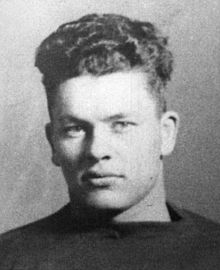 Lambeau at Notre Dame in 1918 | |||
| No. 1, 14, 42, 20 | |||
|---|---|---|---|
| Position: | Halfback | ||
| Personal information | |||
| Born: | April 9, 1898 Green Bay, Wisconsin, U.S. | ||
| Died: | June 1, 1965 (aged 67) Sturgeon Bay, Wisconsin, U.S. | ||
| Career information | |||
| High school: |
| ||
| College: | Notre Dame | ||
| Career history | |||
| As a player: | |||
| As a coach: | |||
| |||
| |||
| Career highlights and awards | |||
| Head coaching record | |||
| Regular season: | 226–132–22 (.624) | ||
| Postseason: | 3–2 (.600) | ||
| Career: | 229–134–22 (.623) | ||
| Record at Pro Football Reference | |||
| Stats at Pro Football Reference | |||
Earl Louis "Curly" Lambeau (April 9, 1898 – June 1, 1965) was an American professional football player and coach in the National Football League (NFL). Lambeau, along with his friend and fellow Green Bay, Wisconsin, native George Whitney Calhoun, founded the Green Bay Packers in 1919. He served as team captain in the team's first year before becoming player-coach in 1920. As a player, Lambeau lined up as a halfback, which in the early years of the NFL was the premier position. He was the team's primary runner and passer, accounting for 35 touchdowns (eight as a rusher, three as a receiver, and 24 as a passer) in 77 games. He won his only NFL championship as a player in 1929.
From 1920 to 1949, Lambeau was the head coach and general manager of the Packers, with near-total control over the team's day-to-day operations. He led his team to over 200 wins and six NFL championships, including three straight from 1929 to 1931. He is tied with rival George Halas of the Chicago Bears and Bill Belichick of the New England Patriots of having the most NFL championships by a coach. Lambeau also coached eight players who went on to be elected into the Pro Football Hall of Fame. With players such as quarterback Arnie Herber and split end Don Hutson, his teams revolutionized the use of the passing game in football. After a falling-out with the Packers' board of directors, Lambeau left the Packers to coach the Chicago Cardinals and Washington Redskins, each for two seasons, before retiring in 1953.
For his accomplishments, Lambeau has been widely recognized and honored. He was named to the NFL 1920s All-Decade Team as one of the top halfbacks in the league's first decade of existence. He was an inaugural inductee to the Pro Football Hall of Fame in 1963 and the Green Bay Packers Hall of Fame in 1970 in recognition for his role as founder, player, and coach of the Packers. Two months after his death in 1965, the Packers home stadium, which is still in use today, was renamed Lambeau Field in his honor.